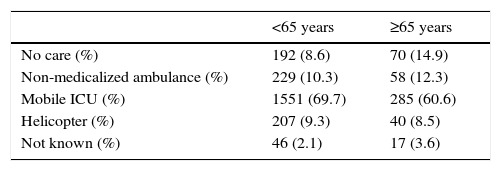We appreciate the interest and comments of Sánchez-Pastor et al. on the preliminary results corresponding to the pilot phase of the Intensive Care Unit Trauma Registry (REgistro de TRAuma en UCI [RETRAUCI]).1,2 The RETRAUCI has become consolidated as a reference in our setting and currently comprises almost 6000 registries corresponding to patients with acute trauma disease, with 49 participating hospitals and 102 investigators nationwide.
Since pre-hospital activation is not a variable contemplated in our registry, and the activation criteria differ among the participating centers, we cannot know how many prehospital activations were received among the 2242 patients included in the pilot phase. The prehospital activation code was present in 10/13 (76.9%) of the participating centers in the pilot phase, which included a total of 2030/2242 (90.5%) of the registered patients.
As regards the origin of the patients, we deduce that the authors have not clearly understood this section, which indicates the origin of the patients upon admission to the Intensive Care Unit (ICU). An out-hospital origin (816 patients; 36.9%) refers to patients directly reaching the ICU from the out-hospital setting, without passing through the emergency care services. An origin from emergency care (784 patients; 35.4%) in turn refers to patients attended in the emergency care services before arriving in the ICU. In both cases, most of the patients were transferred by the out-hospital emergency services. Therefore, rather than an epidemiological difference referred to the characteristics of the patients, this point reflects the variability–not an organizational deficiency–of the severe traumatic disease care systems in our centers.
We found the discussion referred to elderly patients to be particularly interesting. It is well known that the epidemiological profile of severe traumatic disease is changing, and a recent study by our group has illustrated different injury patterns stratified according to 10-year age increments.3 In this regard, elderly patients were more often affected by low-energy trauma complicated by the routine use of antiplatelet drugs and anticoagulants, and were moreover at a greater risk of being run over.3 In the pilot phase of the RETRAUCI, the elderly population (age ≥65 years) represented 21.8% of the total. With regard to pre-hospital care, we observed a greater percentage of patients without medical care or who were assisted by non-medicalized ambulance (Table 1).
Type of out-hospital care among the included patients according to age group.
| <65 years | ≥65 years | |
|---|---|---|
| No care (%) | 192 (8.6) | 70 (14.9) |
| Non-medicalized ambulance (%) | 229 (10.3) | 58 (12.3) |
| Mobile ICU (%) | 1551 (69.7) | 285 (60.6) |
| Helicopter (%) | 207 (9.3) | 40 (8.5) |
| Not known (%) | 46 (2.1) | 17 (3.6) |
ICU, Intensive Care Unit.
The literature is clear in underscoring the existence of infra-triage to reference centers or trauma centers among elderly patients.4 More aggressive management in the context of triage, transferring such patients to reference centers that deal with a larger number of elderly trauma cases, has been associated to improvements in terms of survival.5 The adequate management of this patient population undoubtedly will constitute a challenge over the coming years.
Financial supportThe registry received financial support from the Fundación Mutua Madrileña during three years for the development of an online data compilation tool, granted to the principal investigator of the project (Dr. Chico-Fernández, Reference no.: AP117892013) in representation of the Trauma Neurointensive Care Working Group of the SEMICYUC.
Please cite this article as: Chico-Fernández M, Llompart-Pou JA, Sánchez-Casado M, Ballesteros-Sanz MÁ. Registro de enfermedad traumática grave en España. Med Intensiva. 2017;41:324–325.





